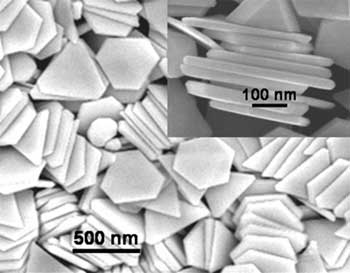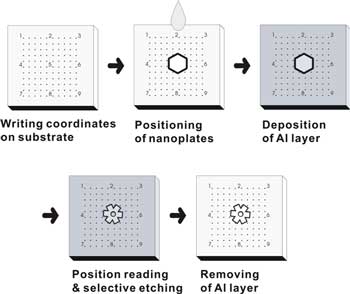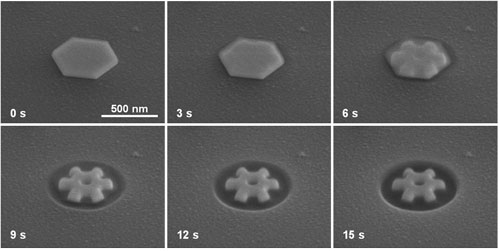| Posted: Dec 04, 2007 | |
Tiny steps towards building nanotechnology machinery |
|
| (Nanowerk Spotlight) Machines usually require various components such as bearings, gears, couplings or pistons. As machines shrink to the micro- and ultimately nanoscale, their components of course need to shrink with them. One of the major obstacles to the realization of intricate nanomachines like nanorobots is the lack of effective processes for building freestanding nanocomponents with specific shapes and sizes. Self-assembly methods produce both organic and inorganic nano-objects with high yields through 'bottom-up' approaches. The shapes, however, in most cases are confined to rather simple forms such as spheres, rods, triangles and cubes etc. and are not suitable for the elementary components of intricate nanomachines. Meanwhile, the 'top-down' approaches including electron beam lithography and micro-contact printing etc. focus on surface patterning or fabrication of suspended objects, although they can fabricate sophisticated nanostructures. So far, the fabrication and assembly of nano-objects with specific shapes and sizes that can act as elementary components for movable nanoelectromechanical systems (NEMS) is only at the conceptual stage. New research results coming from South Korea now offer the first step toward the realization of sophisticated nanomachines, designed to perform specific tasks, with overall dimensions comparable to those of biological cells. | |
| "We have fabricated freestanding gold nanogears smaller than 500 nm in overall size and 60-70 nm in thickness and assembled them tooth to tooth without damage" Dr. Dong Han Ha tells Nanowerk. "This is the first case to our knowledge in which freestanding nanocomponents with precisely designed shape and size are fabricated and assembled. The freestanding nanogears with one center hole surrounded by six teeth were obtained reproducibly by selectively etching the chemically synthesized single-crystalline gold nanoplates using gallium focused ion beam (FIB). The fabrication process is very simple and it takes only 10-20 s to fabricate a nanogear under real time monitoring." | |
| Ha is a Principal Researcher in the Division of Advanced Technology at the Korea Research Institute of Standards and Science (KRISS). Together with his colleagues from KRISS he has demonstrate that blunt AFM tips on stiff cantilevers are effective for the nondestructive manipulation of ductile and flat nano-objects having large contact areas with the substrate. The findings have been reported in the November 20, 2007 online edition of Nanotechnology ("Manipulation of freestanding Au nanogears using an atomic force microscope"). | |
| In previous work, the Korean scientists synthesized high-quality single-crystalline gold nanoplates using a chemical reaction process ("Size-Controlled Synthesis of Machinable Single Crystalline Gold Nanoplates"). | |
 |
|
| FE-SEM image of single-crystalline gold nanoplates synthesized by the chemical reaction method. (Image: Dr. Ha, KRISS) | |
| "The in-plane size and thickness of the nanoplates can be adjusted by controlling the synthesizing condition" says Dr. Yong Ju Yun, a postdoctoral researcher in Ha’s team and first author of the recent Nanotechnology paper. "A lot of high-quality nanoplates motivated us to face the challenge of overcoming the limitations of previous methods, that is, the motivation for our work was to fabricate freestanding nanocomponents with precisely designed shape and size using a lot of high quality nanoplates by combining bottom-up and top-down approaches." | |
| The KRISS team synthesized the gold nanoplates, that were used as the raw material for the fabrication of freestanding nanogears, by reducing hydrogen tetrachloroaurate with a reduced amount of sodium citrate in the presence of polyvinyl pyrrolidone. The team described the details of the fabrication of freestanding nano objects already in 2005 ("Fabrication of versatile nanocomponents using single-crystalline Au nanoplates"). The nanogears are then fabricated by selectively etching the nanoplates sprinkled on SiO2/Si[100] substrates using a Ga+ focused ion beam. | |
 |
|
| Schematic diagram for the fabrication of a nanogear using a Ga+ focused ion beam. (Image: Dr. Ha, KRISS) | |
| "We checked first whether the nanogears can be separated or not from the fabrication sites using a micromanipulator equipped with a tungsten probe" says Ha. "In most cases, the nanogears were severely bent or torn unexpectedly by the tungsten probe before they started to move. It seems that the nanogears bonded to the substrate surface during the FIB process due to the instantaneous melting and re-solidification of gold nanoplates along the brims of etched regions." | |
| To remove the nanogears, and in order to weaken the bond between them and the substrate, the scientists slightly etched the underlying SiO2 layer by dipping the sample into a buffered oxide etch solution for 20 seconds and rinsing it with deionized water at room temperature. Afterwards, oxygen plasma ashing was carried out for 1 minute to remove residual organic materials on the substrate surface. | |
| "After etching the SiO2 layer, we could easily flip, pick up, translate, and rotate the nanogears without damaging them at all, which also confirms that both sides of the nanogears are clean and flat" says Ha. "However, the micromanipulator was not suitable for precisely controlling the position and angle of the nanogears in order to assemble them tooth to tooth. For a precise manipulation of the nanogears we had to use an AFM in contact-mode." | |
 |
|
| Successive FE-SEM images for the fabrication of a nanogear by selective etching of an Au nanoplate using a Ga+ focused ion beam. The time on each frame denotes the elapsed time. (Image: Dr. Ha, KRISS) | |
| Ha expects that the precise manipulation processes combined with the fabrication techniques for the freestanding nanocomponents having arbitrarily designed shapes and sizes will offer the first step to the realization of the development and post-repair of sophisticated nanoelectromechanical systems like nanobots. | |
| "Moreover" he says, "our work also will promote the study on the effects of size and shape on the various properties of nanostructures." | |
| Today, the main challenges for researchers in this field mostly lie in the study and the development of efficient three-dimensional assembling and driving techniques. The assembly process using micromanipulator or atomic force microscope is very tedious and time consuming and does not lend itself to industrial-scale assembly processes. | |
| As for Ha and his team, they are now working on the next step, trying to rotate the nanogears after setting them on fixed shafts. | |
 By
Michael
Berger
– Michael is author of three books by the Royal Society of Chemistry:
Nano-Society: Pushing the Boundaries of Technology,
Nanotechnology: The Future is Tiny, and
Nanoengineering: The Skills and Tools Making Technology Invisible
Copyright ©
Nanowerk LLC
By
Michael
Berger
– Michael is author of three books by the Royal Society of Chemistry:
Nano-Society: Pushing the Boundaries of Technology,
Nanotechnology: The Future is Tiny, and
Nanoengineering: The Skills and Tools Making Technology Invisible
Copyright ©
Nanowerk LLC
|
Become a Spotlight guest author! Join our large and growing group of guest contributors. Have you just published a scientific paper or have other exciting developments to share with the nanotechnology community? Here is how to publish on nanowerk.com.
